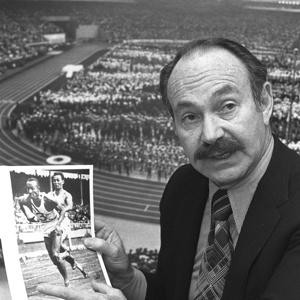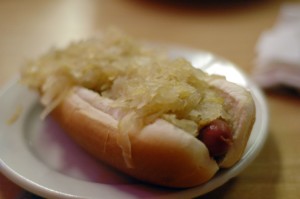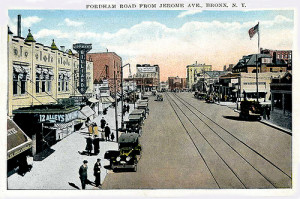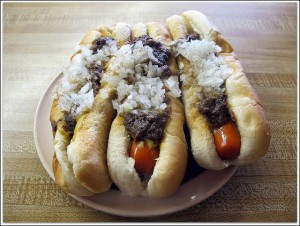“March Madness” is almost finished and HG has been enjoying the basketball battles of the lengthy athletes. When the ball goes in the basket, HG murmurs: “Good like Nedick’s !!”. The late Marty Glickman, the radio voice of New York sports for many years, used that phrase when Nedick’s, a New York hot dog chain, sponsored Knicks games.(Glickman also intoned “Swish!!” when a ball went into the net without hitting the backboard or rim). The phrases became part of New York street language. After making a good shot on the asphalt courts that dotted The Bronx, the player would shout: “Swish!!” or “Good like Nedick’s !!”. (HG had previously mentioned the excellence of the super-cheap Nedick’s lunch of the 1950’s: Two hot dogs on toasted buns. Special, tangy mustard relish. Good orange drink. Cost was less than a dollar). Glickman’s voice was ubiquitous on New York radio. Staccato delivery. Accurate coverage of games. In addition to the Knicks, he was the voice of the New York Giants football team; the Jets; college basketball from Madison Square Garden. Glickman was born in The Bronx of Jewish immigrant parents and raised in Brooklyn where he was known as the “Flatbush Flash.” He was a star football player (Scored two touchdowns in a famous upset of Cornell) and a track team sprinter at Syracuse University. Selected for the U.S. 400-yard relay team in the 1936 Berlin Olympics (along with another Jewish dash man, Sam Stoller). One day before the relay event in Nazi Germany, the Jewish athletes were replaced by Jesse Owens and Ralph Metcalfe, both African-American. The American team won the event in record time and helped Jesse Owens attain immortality by being the first athlete to gain four Olympic medals. Glickman claimed that he and Stoller were replaced because of the anti-Semitism of US Olympic Chairman Avery Brundage who wanted to appease Hitler by not having two Jews standing on the winner’s platform. Glickman was always bitter about the incident even after the US Olympic Committee apologized in 1998 and gave him a gold plaque (Sam Stoller had died earlier). Some other notes: Contrary to the legend, Hitler did shake hands with Owens and Owens carried a photo of the handshake in his wallet the rest of his life. Owens was angered that President Franklin D. Roosevelt never invited him to the White House or sent him a congratulatory message. (Hitler said Black athletes should be barred from future Olympic games because their physiques were “superior” to those of Whites). Two years after the Berlin Olympics, in 1938, Hitler awarded Brundage’s construction company the contract to build the German Embassy in Washington, D.C.
Glickman Was “Good Like Nedick’s!!!!”
April 1st, 2016 § 2 comments § permalink
Tube Steaks and Sausages
March 29th, 2016 § 0 comments § permalink
During HG’s many years in New York, the greedy fellow managed to eat many scores of hot dogs. The tube steak was an essential food during HG’s financially challenged young years. But, even as HG prospered, the HG appetite for hot dogs remained intense. Favorite venue for the treat was Papaya King on E.86th Street and Third Avenue. Two dogs with mustard and sauerkraut and a Pina Colada drink. Perfect. The Nedick’s chain used to be omnivorous in New York (Its Herald Square location fronting on Macy’s was possibly the busiest hot doggery in the world). The dogs were served on a toasted bun spread with a special mustard relish and accompanied by a very good orange drink. Very inexpensive. The chain disappeared in the 1950’s. The Riese organization tried to revive the brand in 2003. The effort failed. Nathan’s Famous (The original is still located on the Coney Island boardwalk and there are now locations throughout the country) served an exemplary dog. HG, however, rarely ate them but favored Nathan’s clams on the half shell, fried soft shell crab sandwiches and other good things from the sea. Nathan’s sloppy, messy, yummy chow mein sandwich on a hamburger bun, was another HG fave. New York once had many traditional Jewish delicatessens serving good Hebrew National or Isaac Gellis dogs plus “Specials” (Plump, garlicky knockwursts). HG always thought the stands offering Sabrett’s “dirty water” hot dogs were vile. According to SJ, if you want a great dog in downtown New York, go to Katz’s, the pastrami emporium. Though the pastrami may have gone downhill, the hot dog is big time. As for sausage, HG’s favorite was the New York italian pork sausage containing plenty of fennel seeds. Best served from the back of a truck in Greenwich Village. The sausage was laid on a wedge of Italian bread and topped with plentiful fried onions and peppers. All of the many inexpensive “red sauce” Italian restaurants of HG’s youth served savory, abundant platters of sausage and peppers. Accompanied by a side dish of buttered and parmesan dusted ziti and washed down with cheap Chianti from a wicker wrapped bottle, this was hearty affordable eating. New York once had scores of German restaurants dispensing grilled bratwurst with sauerkraut and fried potatoes. The dish was flanked by a big glass of good beer. The best brats were found at Luchow’s on 14th Street and Blue Ribbon in the theater district. Both long closed, alas. When in Paris, HG enjoys boudin noir and boudin blanc. The boudin noir, a blood sausage, is usually accompanied by sautéed apple slices,. A winning combination. HG does not favor the excrement smelling French chitterling sausage. HG considers it a French aberration akin to that nation’s worship of Jerry Lewis and Mickey Rourke.
Bronx Memories – Keep it Personal
August 28th, 2015 § 5 comments § permalink
HG has many fond memories of boyhood in The Bronx (a boyhood that took place more than seven decades ago). It was a very Jewish borough. Yes, there were substantial Italian, Irish and African-American enclaves but Jews were in the majority and the borough culture had a very Jewish tone. Affluent Jews lived on the stately avenue, The Grand Concourse (official name was Grand Concourse and Promenade). GC was the dividing line defining class and economic status. Working class to the east. Lower middle class to the west. HG always loved to walk GC from Kingsbridge Road to W. 161 st. Much to see. The little cottage on Kingsbridge where Edgar Allan Poe lived and wrote for a short period of time. Alexander’s Department Store on the corner of Fordham Road. Loew’s Paradise movie theater with its ornate interior and ceiling of sparkling stars. (It was near W.183rd and across the street were two culinary destinations—Sutter’s Bakery and J. S. Krum soda fountain and confectionary). Also on GC was the Ascot movie theater. It was an intimate movie house with a demure facade. It was here that young HG sat in the upper balcony, puffed cigarettes and watched great foreign films like “Grand Illusion” and “Blue Angel.” There was a lingerie shop nearby with window mannequins bedecked in fashionable bras and girdles (As can be imagined, young HG gave this enraptured attention). Further south were beautiful white brick art deco apartment houses (many with entry facades decorated with fanciful mosaics). There was also the dignified Andrew Freedman home for impoverished gentlefolk (fronted by a meticulous green lawn). Other landmarks were the lofty Lewis Morris Apartments where many doctors had their offices and the Concourse Plaza Hotel where teams playing the Yankees often lounged in the lobby before and after games. West 16lst Street concluded HG’s stroll. The striking art deco Bronx County Court House on GC and off to the west, Yankee Stadium on River Avenue. Nearby was the Earl movie theater (striking facade), the Jerome Cafeteria, the great Addie Vallins soda fountain and Nedick’s hot dogs. Excellent nourishment was always close at hand in The Bronx of yesteryear. The broad east-west shopping streets (Kingsbridge, Fordham, Mt. Eden, Burnside, W. 167th, W. 170th, W. 16lst contained splendid Jewish delicatessens, bakeries, “appetizing” stores (stores that specialized in smoked fish, pickles, olives, etc.). There were some good cafeterias (but few restaurants). And, of course, plenty of butchers, fish mongers and green grocers for the industrious home cooks. The Bronx was a borough of apartment dwellers. In the low rent areas, tenants treated the sidewalks as extensions of their living rooms. In warm weather, men in their undershirts played cards. Women chatted and overlooked the play of lively children. Little HG and his pals played relentlessly. Punchball. stickball, “association” football, “stoop” ball, ring-o-leevio, hide and seek, johnny-on-the-pony, kick the can. Later, there was softball, basketball and sandlot football. (HG was a sandlot backfield star and played in tough games throughout the borough. There was ethnic rivalry plus the teams bet on themselves, winner take all. The ref held the money. Many fist fights. A good preparation for the often rocky game of life that lay ahead). The Bronx was a Democratic Party fiefdom James J. Lyons was Borough President and Ed Flynn was “The Boss.” A smooth functioning machine that paid close personal attention to its constituents. An example: HG was a bright, obedient elementary school student, always receiving A’s for academic excellence and conduct. After the final term report card, HG’s parents would receive a letter from Borough President Lyons. It read in part: “Your son Gerald’s excellent school performance has come to my attention. You must be very proud. Congratulations. I am sure the fine home you provide has aided Gerald in achieving success.” HG’s mother treasured these letters and preserved them in a special folder (alas, destroyed in a fire years later). She would have walked over hot coals in order to get to a polling place and vote the straight Democratic ticket. During BSK’s years as a Colorado political strategist, BSK mentioned these letters to Democratic Congressman Ed Perlmutter. “Make it personal, Ed. Make it personal.” Ed followed her advice. He has never lost an election.
Rhody Rapture
March 18th, 2013 § 0 comments § permalink
The 10-cent Nedick’s hot dog (Nedick’s, now shuttered, was a New York City based fast food chain predating Mickey Dee). The Sabrett’s hot water dog with its odd tomato and onion sauce. The Chicago hot dog replete with “sport” peppers, celery salt, pickles and other greenery. The Bronx kosher deli dog with hot mustard and sauerkraut. The estimable doggie sold in the Costco food court. All of these have provided HG with varying degrees of pleasure. But, HG’s favorite canine can only be found in the small state of Rhode Island. Yes, Rhody is of modest size but it specializes in big, highly idiosyncratic flavors. And, for sheer oddity (as well as a strange, hard-to-pin-down savoriness) the “New York System Hot Wiener” (accompanied by a cold Coffee Milk) stands out and makes HG bark with delight. Permit HG to do a scholarly exegesis on the proletarian pup: The wiener used in a NY System is either the skinless product, the Little Rhody or the Saugy which has a natural English sheep casing (giving it a characteristic snap). Alone, or in a roll, these small sized dogs are certainly good but nothing to write an HG posting about. But, then comes the sauce. Ah, the sauce. The French say cheese is milk’s leap into immortality (When the French get things right, they get them really right). And, the spicy meat sauce that smothers the Hot Wiener makes the tube steak leap into nosh immortality. Created by Greek immigrants in the early 1920s (or somewhere around there) the meat sauce is truly the flavor of the old world (Europe, Middle East) meeting (or meating!) the new. There are hints of Italian Ragu and Greek Mousaka. Bits of Texas chili. Smidgens of Middle Eastern kefta (possibly due to tiny infusions of cinnamon, cumin and possibly all spice). The faintest evocation of Portuguese stews. But, why try to analyze it. Like a kiss from a beautiful woman, just enjoy it and don’t intellectualize. One would think that the sauce could stand alone, No. Rhode Islanders further enhance the Hot Wiener with mustard, chopped onion and celery salt. So, what do you drink with his extravaganza? Just as HG believes the only appropriate drink to guzzle with a New York hot pastrami sandwich is the “Jewish Champagne” that is Dr. Brown’s Cel-Ray Tonic, Rhodys opt for Coffee Milk. This beverage is made with two tablespoons of locally made Autocrat Coffee Syrup mixed with icy milk. Stirred well. Simple. Perfect. HG believes the Rhode Island fondness for coffee milk is somehow linked to the Rhode Island fondness for coffee and donuts at Dunkin’ Donuts. Rhodys are the nation’s largest per capita consumers of donuts (the Providence sports and entertainment center is the Dunkin’ Donuts Arena known to all followers of Providence and Rhode Island University basketball teams as “the Dunk).
Given all of this yummy history, HG’s heart picked up a beat today when he opened a package from the Family R.: Gifted Daughter Lesley, Profesore/Dottore Massimo, Glorious Granddaughters Arianna and Sofia. The little bundle contained a package of Olneyville N.Y. System, R.I.’s Best Hot Wieners, Hot Wiener Sauce Spice Mix (since 1946) plus a bottle of Autocrat, enough to make many glasses of Coffee Milk “The Official State Drink of Rhode Island.” The enclosed card read: “A taste of Rhode Island for Hungry Gerald.” HG has a kind and thoughtful family. HG will sample these good RI things while listening to Blossom Dearie sing: “Rhode Island Is Famous For You.”



